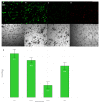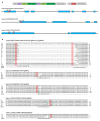Protoplast-Based Transient Expression and Gene Editing in Shrub Willow (Salix purpurea L.)
- PMID: 36559601
- PMCID: PMC9784668
- DOI: 10.3390/plants11243490
Protoplast-Based Transient Expression and Gene Editing in Shrub Willow (Salix purpurea L.)
Abstract
Shrub willows (Salix section Vetrix) are grown as a bioenergy crop in multiple countries and as ornamentals across the northern hemisphere. To facilitate the breeding and genetic advancement of shrub willow, there is a strong interest in the characterization and functional validation of genes involved in plant growth and biomass production. While protocols for shoot regeneration in tissue culture and production of stably transformed lines have greatly advanced this research in the closely related genus Populus, a lack of efficient methods for regeneration and transformation has stymied similar advancements in willow functional genomics. Moreover, transient expression assays in willow have been limited to callus tissue and hairy root systems. Here we report an efficient method for protoplast isolation from S. purpurea leaf tissue, along with transient overexpression and CRISPR-Cas9 mediated mutations. This is the first such report of transient gene expression in Salix protoplasts as well as the first application of CRISPR technology in this genus. These new capabilities pave the way for future functional genomics studies in this important bioenergy and ornamental crop.
Keywords: Salix; gene editing; protoplasts.
Conflict of interest statement
The authors declare no conflict of interest.
Figures



References
-
- Argus G.W. Infrageneric classification of Salix (Salicaceae) in the new world. Syst. Bot. Monogr. 1997;52:1–121. doi: 10.2307/25096638. - DOI
-
- Kuzovkina Y.A., Weih M., Romero M.A., Charles J., Hust S., McIvor I., Karp A., Trybush S., Labrecque M., Teodorescu T.I. Salix: Botany and global horticulture. Hortic. Rev. 2007;34:447–489.
-
- Stoof C.R., Richards B.K., Woodbury P.B., Fabio E.S., Brumbach A.R., Cherney J., Das S., Geohring L., Hansen J., Hornesky J. Untapped potential: Opportunities and challenges for sustainable bioenergy production from marginal lands in the Northeast USA. BioEnergy Res. 2015;8:482–501. doi: 10.1007/s12155-014-9515-8. - DOI
-
- Guan Q., He M., Ma H., Liao X., Wang Z., Liu S. Construction of genetic transformation system of Salix mongolica: In vitro leaf-based callus induction, adventitious buds differentiation, and plant regeneration. Plant Cell Tissue Organ Cult. (PCTOC) 2018;132:213–217. doi: 10.1007/s11240-017-1265-9. - DOI
Grants and funding
LinkOut - more resources
Full Text Sources
Research Materials

